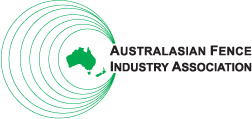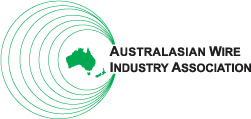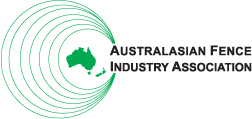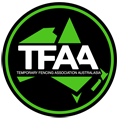Previously chain-link fencing has been specified as chainwire fencing, chainmesh fencing, wire mesh fencing or by a generic brand name called Cyclone fencing.
The Australasian Fence Industry Association is committed to maintaining high standards for the supply and installation of chain-link (chain mesh) security fencing.
Following frequent requests from architects, engineers, specifiers, local government authorities and fencing contactors for information on chainmesh and chainwire security fencing details, the AFIA has produced two standard chain-link security fencing drawings.
The fencing details on these drawings are compliant with the Australian standard AS1725.1- 2010, Chain-link fabric Fencing – Security fences and gates.
First drawing features a heavy duty chain-link security fence with 3.15mm wire for longer, durable service life in higher security applications.
Second drawing, light duty chain-link security fence, has 2.50mm wire and may be selected for light industrial applications where security and durability are a lower priority.
To download a FREE PDF copy of these drawings clicks on this link which will open in a new tab / window.
However for a more comprehensive understanding of the Chain Link Fencing Standards we recommend that all stakeholders should consider purchasing a download copy or hard copy of the complete Australian standard AS1725.1 - 2010 Chain-link fabric fencing – Security fences and gates contact SAI Global Limited Phone 13 12 42, email [email protected]
The Australian Standard for Chain-link Fabric Fencing and Gates (aka Chain Wire Mesh) AS1725-2003 – “Chain-link fabric security fences and gates” was updated in September 2010, with the new standard known as AS1725-2010 – Parts 1 to 5.
The new version expands on the main application areas of chain-link fabric fencing and gates, but ensures that the five (5) different sections, four (4) which are new, are consistent in both types and applications of materials and installation standards.
AS1725-2010 – Chain-link Fabric Fencing
Part 1 – Security Fences and Gates
- Replaces AS1725-2003
- Part 1 – Essentially has only minor changes to AS1725-2003, e.g.
- In addition to AS/NZS 1163, Galvanized Pipe that meets either AS1074 & EN10255 is also now accepted.
- Chain-link Fabric (CLF) and associated wire made from Fuse Bonded Polymer (FBP) wire, with a base metallic coating not less than W02Z has been added to AS1725-2010.
Summary of major specifications which remain unchanged from AS1725-2003 to AS1725-2010 - Part 1
- DN50 Medium Grade (3.6mm wall thickness) galvanized pipe posts are the minimum size & type posts that can be used for all Terminal posts, i.e.; End, Corner & Gate posts.
- DN40 Medium, Light or Extra-Light galvanized pipe posts are the three (3) DN40 pipe grades that are listed in AS1725-2010 which can be specified as the minimum size for Intermediate posts.
- Chain-link fabric and associated wire made from; Heavy Galvanized (HG) W10Z wire, Zinc/Aluminium-Alloy (ZA) W05Z5A wire& PVC (Polyvinyl Chloride) wire with a base metallic coating not less than W02Z,remains unchanged and are all accepted.
- Chain-link fabric and associated wire made from Standard Galvanized (SG) W02Z wire does not meet the minimum standard for any parts of AS1725-2010
- The core wire diameter for the manufacture of chain-link fabric is either; 2.50mm dia. Light Duty or 3.15mm dia. Heavy Duty.
- The maximum pitch (diamond) size for chain-link fabric is 50mm nominal pitch, measured diagonally across the diamond.
- Post spacing’s remain unchanged at a maximum of 3330mm post centres.
- Wire used for lacing wire MUST be 2.00mm core wire for all parts of AS1725-2010, i.e. 1.57mm core Tie wire can be only used to secure chain link fabric to horizontal cable wires.
Part 2 – Tennis Court Fencing – Commercial
- Includes guidelines for purchasers to assist with the selection and nomination of components to establish the final fence specifications and design requirements for Commercial Tennis Court Fencing.
- Chain-link fabric: 45mm pitch x 3.15mm Heavy Duty is the minimum duty CLF that is specified, i.e. CLF made from Light Duty 2.50mm core wire is not recommended in Commercial Tennis Court Fencing applications.
- Commercial Tennis Courts provide for a heavier design specification.
- Intermediate posts have been increased to a minimum DN50 (60.3mm OD) Medium or Light Grade pipe posts.
- Corner posts shall be a minimum DN80 (88.9mm OD) galvanized Medium Grade pipe.
- Extra Light galvanized pipe does not comply with this section of Tennis Court Fencing.
- Post spacing’s at a maximum of 3330mm post centres.
- The intermediate fence members within this Standard make no allowance for signage, wind break materials or creepers attached to tennis court fencing.
- An engineer’s recommendation and design for fence members and/or attachment of backstays should be sought depending on wind break materials proposed and wind category area the fence is exposed to.
Part 3: Tennis Court Fencing – Private/Residential
- Includes, guidelines for purchasers to assist with the selection and nomination of their choice of components, to establish the final fence specifications and design requirements for tennis court Private/Residential fencing, to suit their site application.
- Chain-link fabric: both 45mm pitch x 3.15mm Heavy Duty CLF or 45mm pitch x 2.50mm Light Duty CLF can be specified.
- This section provides for a lighter design specification for Private/Residential Tennis Courts, compared to Commercial Tennis Courts.
- The minimum size for Corner posts has been increased from DN50 (60.3mm OD) galvanized Medium Grade pipe to DN65 (76.1mm OD) galvanized Medium Grade pipe.
- Extra Light galvanized pipe does not comply with this section of Tennis Court Fencing.
- Post spacing’s at a maximum of 3330mm post centres.
Part 4: Cricket Net Fencing - Enclosures.
- Includes, guidelines for purchasers to assist with the selection and nomination of their choice of components, to establish the final fence specifications and design requirements, taking into account durability for Cricket Net Enclosure fencing, to suit their site application.
- Extra Light galvanized pipe does not comply with the minimum standards for Cricket Net Enclosures.
- The minimum size for Corner posts has been increased from DN50 (60.3mm OD) galvanized Medium Grade pipe to DN65 (76.1mm OD) galvanized Medium Grade pipe.
- The minimum size for End posts has been increased from DN50 (60.3mm OD) galvanized Medium Grade pipe to DN80 (88.9mm OD) galvanized Medium Grade pipe, to allow for gates to be hinged off the end of the enclosure, if required.
- Fence design for Cricket Net Enclosures must be installed with a Top & Bottom Rail, as a minimum.
- The minimum size pipe for Top, Bottom & Roof support pipe rails has been increased from DN32 (42.4mm OD) galvanized Medium or Light Grade pipe to DN40 (48.3mm OD) galvanized Medium or Light Grade pipe.
- NB: Hip roofs which span over 9m or 3 bays will require DN50 (60.3mm OD) galvanized Medium Grade pipe to specific areas of the hip roof as detailed on drawings.
- Roof pipe rails to have a maximum of 1500mm spacing in either direction.
- Chain-link fabric: 3.15mm Heavy Duty is the minimum wire diameter that can be specified for the CLF; with 40mm pitch fabric required to the rear of the nets and 50mm pitch fabric to the side fences and roof section.
- The chain-link fabric shall be placed on the inside face of the fence posts. For safety purposes, the chain-link fabric should be installed to both faces of all internal dividing fences, to reduce the risk of a cricket ball impacting with an exposed post and rebounding back at the batter or bowler.
- Roof Design, either a Flat roof or Pitched Hip roof design.
- Post spacing’s; unlike other types of chain-link fabric fencing which allows for a maximum post spacing of 3330mm, the maximum distance for post spacing’s for CLF Cricket Net Fencing is 3000mm nominal centres.
Part 5: Sports Ground Fencing.
- Includes guidelines for purchasers to assist with the selection and nomination of their choice of components, to establish the final fence specifications and design requirements, taking into account durability of sports ground fencing, to suit their site application.
- Provides five (5) design types with drawings of low fencing. Principal difference is the specified pipe sizes of Posts & Rails for each type.
- This allows Councils and other stakeholders to select their own required standard for sports ground fencing.
- Type 1. Extra Heavy, Type 2, Heavy, Type 3. Medium, Type 4. Light , Type 5 Extra Light
- Chain-link fabric: 50mm pitch x 3.15mm Heavy Duty CLF is the minimum quality that can be specified, in Types; 1, 2, 3 & 4.
- Pipe selection for Types 1 to 4 shall be either all medium grade or medium/light grade.
- Chain-link fabric: 50mm pitch x 2.50mm Light Duty CLF is permitted only for Type 5 - Extra Light Durability.
- Extra Light galvanized pipe can only be specified for Type 5 - Extra Light Durability.
- Post spacing: unlike other types of chain-link fencing which allows for a maximum post spacing of 3330mm, the maximum distance for post spacing for Sports Ground Fencing is 2400mm centres.
To obtain a copy of the Australian Standard:
Order by phone, email and by traditional mail order;
Phone: 1800 035 822
International: +61 2 9237 6171
Email: [email protected]
Post: GPO Box 476 Sydney NSW 2001 Australia



